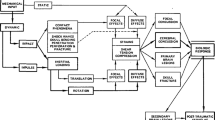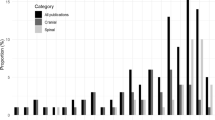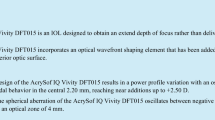Abstract
Visual impairment and intracranial pressure (VIIP) syndrome is characterized by a number of permanent ophthalmic changes, including loss of visual function. It occurs in some astronauts during long-duration spaceflight missions. Thus, understanding the pathophysiology of VIIP is currently a major priority in space medicine research. It is hypothesized that maladaptive remodeling of the optic nerve sheath (ONS), in response to microgravity-induced elevations in intracranial pressure (ICP), contributes to VIIP. However, little is known about ONS biomechanics. In this study, we developed a custom mechanical testing system that allowed for unconfined lengthening, twisting, and circumferential distension of the porcine ONS during inflation and axial loading. Data were fit to a four-fiber family constitutive equation to extract material and structural parameters. Inflation testing showed a characteristic “cross-over point” in the pressure–diameter curves under different axial loads in all samples that were tested; the cross-over pressure was \(10.3 \pm 0.95\) mmHg (\(\hbox {mean} \pm \hbox {SEM}\)). Large sample-to-sample variations were observed in the circumferential strain, while only modest variations were observed in the circumferential stress. Multiphoton microscopy revealed that the collagen fibers of the ONS were primarily oriented axially when the tissue was loaded. The existence of this cross-over behavior is expected to be neuroprotective, as it would avoid optic nerve compression during routine changes in gaze angle, so long as ICP was within the normal range. Including these observations into computational models of VIIP will help provide insight into the pathophysiology of VIIP and could help identify risk factors and potential interventions.







Similar content being viewed by others
References
Alexander D et al (2012) Evidence report: risk of spaceflight-induced intracranial hypertension and vision alterations. NASA Report
Baek S, Gleason R, Rajagopal K, Humphrey J (2007) Theory of small on large: potential utility in computations of fluid–solid interactions in arteries. Comput Methods Appl Mech Eng 196:3070–3078
Carboni M, Desch GW, Weizsäcker HW (2007) Passive mechanical properties of porcine left circumflex artery and its mathematical description. Med Eng Phys 29:8–16
Coudrillier B, Pijanka JK, Jefferys JL, Goel A, Quigley HA, Boote C, Nguyen TD (2015) Glaucoma-related changes in the mechanical properties and Collagen micro-architecture of the Human Sclera. PloS One 10:e0131396
Dobrin PB (1986) Biaxial anisotropy of dog carotid artery: estimation of circumferential elastic modulus. J Biomech 19:351–358
Girard M, Suh J-KF, Hart RT, Burgoyne CF, Downs JC (2007) Effects of storage time on the mechanical properties of rabbit peripapillary sclera after enucleation. Curr Eye Res 32:465–470
Gleason R, Gray S, Wilson E, Humphrey J (2004) A multiaxial computer-controlled organ culture and biomechanical device for mouse carotid arteries. J Biomech Eng 126:787–795
Greenwald S, Moore J, Rachev A, Kane T, Meister J-J (1997) Experimental investigation of the distribution of residual strains in the artery wall. J Biomech Eng 119:438–444
Hansen H-C, Helmke K (1997) Validation of the optic nerve sheath response to changing cerebrospinal fluid pressure: ultrasound findings during intrathecal infusion tests. J Neurosurg 87:34–40
Hansen L, Wan W, Gleason RL (2009) Microstructurally motivated constitutive modeling of mouse arteries cultured under altered axial stretch. J Biomech Eng 131:101015
Hansen HC, Lagreze W, Krueger O, Helmke K (2011) Dependence of the optic nerve sheath diameter on acutely applied subarachnoidal pressure-an experimental ultrasound study. Acta Ophthalmol 89:e528–e532
Holzapfel GA, Gasser TC, Ogden RW (2000) A new constitutive framework for arterial wall mechanics and a comparative study of material models. J Elast Phys Sci Solids 61:1–48
Humphrey J (2008) Vascular adaptation and mechanical homeostasis at tissue, cellular, and sub-cellular levels. Cell Biochem Biophys 50:53–78
Humphrey J, Kang T, Sakarda P, Anjanappa M (1993) Computer-aided vascular experimentation: a new electromechanical test system. Ann Biomed Eng 21:33–43
Kaiser GM, Frühauf NR (2007) Method of intracranial pressure monitoring and cerebrospinal fluid sampling in swine. Lab Anim 41:80–85
Kang T, Humphrey J (1991) Finite deformation of an inverted artery. Advances in bioengineering ASME, New York
Kramer LA, Sargsyan AE, Hasan KM, Polk JD, Hamilton DR (2012) Orbital and intracranial effects of microgravity: findings at 3-T MR imaging. Radiology 263:819–827
Liu D, Kahn M (1993) Measurement and relationship of subarachnoid pressure of the optic nerve to intracranial pressures in fresh cadavers. Am J Ophthalmol 116:548–556
Mader TH et al (2011) Optic disc edema, globe flattening, choroidal folds, and hyperopic shifts observed in astronauts after long-duration space flight. Ophthalmology 118:2058–2069
Matsumoto T, Hayashi K (1996) Stress and strain distribution in hypertensive and normotensive rat aorta considering residual strain. J Biomech Eng 118:62–73
Morris HJ, Tang J, Perez BC, Pan X, Hart RT, Weber PA, Liu J (2013) Correlation between biomechanical responses of posterior sclera and IOP elevations during micro intraocular volume change. Investig Ophthalmol Vis Sci 54:7215–7222
Nelson ES, Mulugeta L, Myers JG (2014) Microgravity-induced fluid shift and ophthalmic changes. Life 4:621–665
Olsen TW, Sanderson S, Feng X, Hubbard WC (2002) Porcine sclera: thickness and surface area. Investig Ophthalmol Vis Sci 43:2529–2532
Quigley H, Anderson D (1977) Distribution of axonal transport blockade by acute intraocular pressure elevation in the primate optic nerve head. Investig Ophthalmol Vis Sci 16:640–644
Rachev A, Hayashi K (1999) Theoretical study of the effects of vascular smooth muscle contraction on strain and stress distributions in arteries. Ann Biomed Eng 27:459–468
Rachev A, Manoach E, Berry J, Moore J (2000) A model of stress-induced geometrical remodeling of vessel segments adjacent to stents and artery/graft anastomoses. J Theor Biol 206:429–443
Ruiz-Ederra J, García M, Hernández M, Urcola H, Hernández-Barbáchano E, Araiz J, Vecino E (2005) The pig eye as a novel model of glaucoma. Exp Eye Res 81:561–569
Taban M, Spoor TC, McHenry JG, Sadun AA (2001) Histopathology and ultrastructural examination of optic nerve sheath biopsies after optic nerve sheath decompression with and without mitomycin. Ophthalmic Plast Reconstruct Surg 17:332–337
Tonge TK, Murienne BJ, Coudrillier B, Alexander S, Rothkopf W, Nguyen TD (2013) Minimal preconditioning effects observed for inflation tests of planar tissues. J Biomech Eng 135:114502
Wan W, Dixon JB, Gleason RL Jr (2012) Constitutive modeling of mouse carotid arteries using experimentally measured microstructural parameters. Biophys J 102:2916–2925
Weizsäcker HW, Lambert H, Pascale K (1983) Analysis of the passive mechanical properties of rat carotid arteries. J Biomech 16:703–715
Zaucha MT et al (2009) A novel cylindrical biaxial computer-controlled bioreactor and biomechanical testing device for vascular tissue engineering. Tissue Eng Part A 15:3331–3340
Acknowledgments
This work was supported by the National Space Biomedical Research Institute through NCC 9-58, by NASA’s Human Research Program through the Digital Astronaut Project (DAP) and NASA Grant Number NNX13AP91G, and by the Georgia Research Alliance. We would like to thank DeVon Griffin, Beth Lewandowski, and Paula Dempsey for administrative support.
Author information
Authors and Affiliations
Corresponding author
Electronic supplementary material
Below is the link to the electronic supplementary material.
10237_2016_800_MOESM1_ESM.tif
Fig. S1: Axial stress-strain response of 6 different porcine ONSs at an axial load of approximately 5 mN. Axial a) Green strain and b) Cauchy stress at pressures of 7 mmHg, 15 mmHg, and 30 mmHg, normalized to the mean strain and mean stress over all samples at 7, 15, and 30 mmHg, respectively TIFF 243 KB
Rights and permissions
About this article
Cite this article
Raykin, J., Forte, T.E., Wang, R. et al. Characterization of the mechanical behavior of the optic nerve sheath and its role in spaceflight-induced ophthalmic changes. Biomech Model Mechanobiol 16, 33–43 (2017). https://doi.org/10.1007/s10237-016-0800-7
Received:
Accepted:
Published:
Issue Date:
DOI: https://doi.org/10.1007/s10237-016-0800-7




